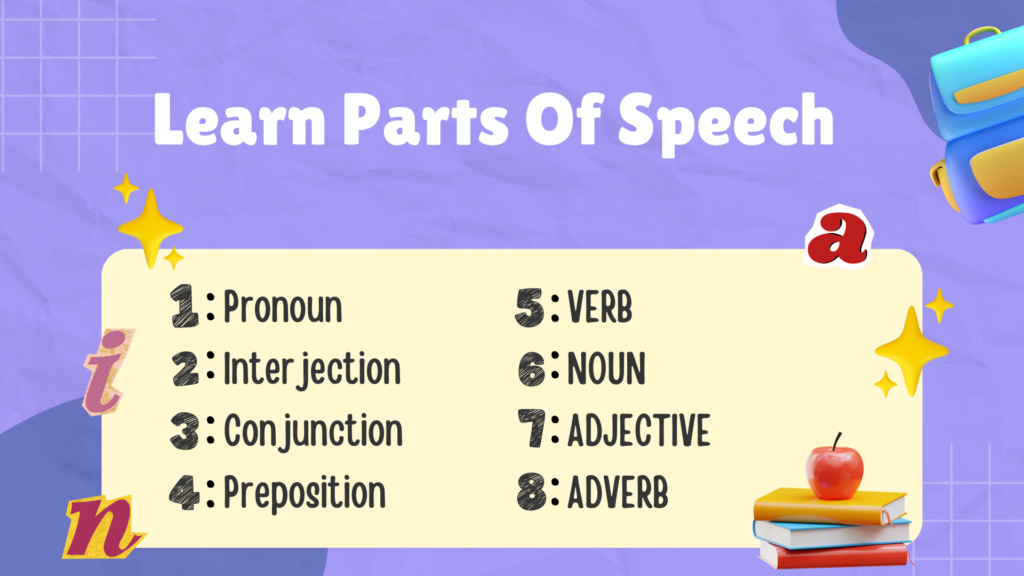
Welcome to a Fascinating Journey into English Grammar. Do you ever find yourself struggling to identify nouns, verbs, adjectives, and other parts of speech? If so, you’re in the right place. Join us as we embark on an exciting exploration of the world of grammar. In just a few minutes, you’ll gain a solid understanding of the different parts of speech. So, let’s not hesitate any longer and delve right into this enriching experience!
Parts of speech
There are eight parts of speech:
| Verb |
| Noun |
| Adjective |
| Adverb |
| Pronoun |
| Interjection |
| Conjunction |
| Preposition |
These parts of speech allow us to structure a grammatically correct sentence, as each has a different function within a sentence. Let’s examine each of the 8 parts of speech.
Verb
The verb is one of the eight parts of speech; it describes an action or experience. For example:
| Play | Read |
| Comprehend | Bake |
| Cook |
Examples
Sara finished her assignment on time to avoid any complications.
This statement contains two verbs: “finished” and “Avoid.”
Ahmed secured the highest marks in his final exams.
The verb in this sentence is “secured.“
Noun
A noun names a person, place, thing, or idea; for example,
| House | Mother | Woman | Elephant | Pacific Ocean |
Let’s understand through a few examples:
My mother is a lovely person
The noun in this sentence is mother.
Jim went to the market to buy a table.
There are three nouns in this sentence. The first noun is ‘Jim’ because it’s a person’s name. The second noun is ‘market’ because it is the name of a place. The third noun is ‘table’ because it is the name of an object.
Adjective
The next one on the list is an adjective. An adjective describes a noun or a pronoun. For example,
| Tall | Pretty | Intelligent | Delicious |
Fatima owns a modern car with exceptional features.
The adjectives in this sentence are modern and exceptional because they describe Fatima’s car.
Adverb
Up next, we have an adverb. An adverb describes a verb, an adjective, or another adverb. The adverb tells us how, where, and when an action occurs. For example:
| Gradually | Yesterday | Elegantly | Soon |
She is always late for the office.
The adverb in this sentence is always. It is also important to note that late is an adverb and an adjective.
Pronoun
Let’s understand the use of a pronoun. A pronoun is used to replace the name of a person, place, thing, or idea in a sentence. For example
| I | She | Our | They | It |
Bob is a loyal companion. He always helps me with my work.
The pronoun in this sentence is “he.”
They have invited me to the wedding.
The pronoun in this sentence is “they.”
Interjection
An interjection is used to express strong emotion and is often followed by an exclamation mark, for example, Wow, oh, hey, oops
Here we have some examples:
Wow, your performance is absolutely amazing!
The interjection in this sentence is wow.
Hey, it has been a while since I last saw you.
The interjection in this sentence is hey.
Conjunction
The conjunction connects words, phrases, or clauses in a sentence. For example
- Because
- And
- But
- Although
She didn’t go to school because she was unwell.
The conjunction in this sentence is because.
Although it was raining, I decided to go for a run in the park.
The conjunction in this sentence is although.
Preposition
Prepositions describe the place, time, or direction. It is used before a noun or pronoun
For example
- Behind
- Above
- In
- Over
The cat jumped over the fence.
The preposition in this sentence is over.
The cat is behind the couch.
The preposition in this sentence is behind.
Thanks for taking the time to read this article and understand the parts of speech. If you found it helpful, please consider sharing it with others who may benefit from this knowledge. Don’t forget to subscribe to our channel for more educational content like this. We value your input, so if you have any questions or ideas for future articles, please feel free to contact us. We’re committed to providing engaging and informative content, so stay tuned for more insightful articles. Until next time, happy learning!
Visit Our YouTube Channel